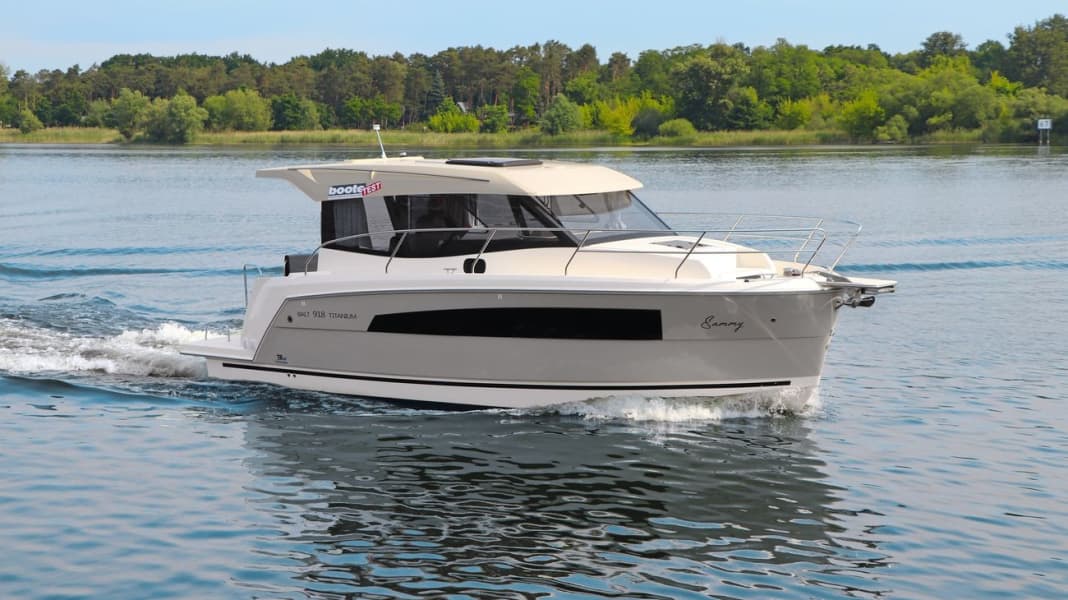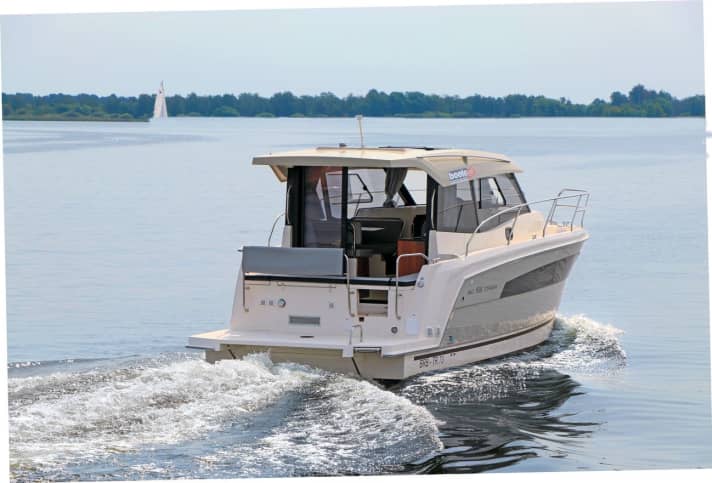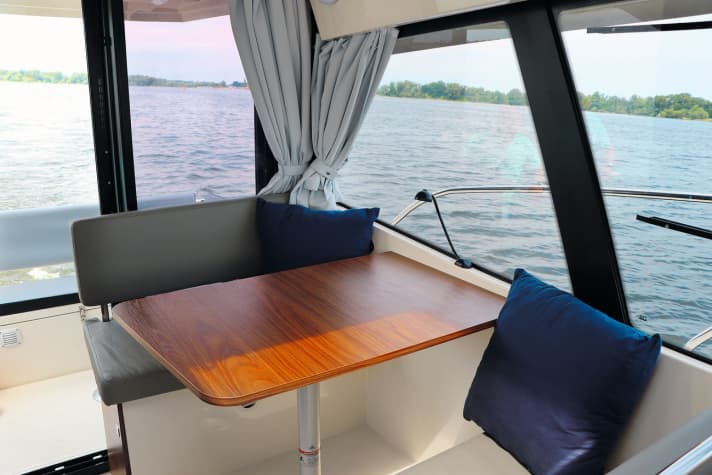
Anyone who finds out more about the Balt boats quickly realises that they are practical cabin cruisers. They are designed to appeal to charter companies as well as private owners who want to travel in comfort. Our test boat, the Balt 918 Titanium, has three cabins, a wet room, saloon with steering position and pantry block as well as a covered cockpit. Everything is designed to maximise efficiency. A statement on the website of our test boat dealer T&R Yachthandel: "The idea in the yacht lies in the needs of customers who value a boat not for its size, but for its functionality."
Of course, the motorisation must also be suitable; outboards from 40 to 150 hp or built-in diesels up to a maximum of 80 hp are recommended. We are travelling with just such a diesel. However, it does not transfer its power to the water via a reversing gear, but via a sail drive, which, like large POD drives, is located in the bottom of the boat. The latter is rotatable and thus steers the boat. In the 918 Titanium, however, it is "fixed" and a conventional rudder blade takes over the steering of the boat. This allows turning circles of around 1 1/2 boat lengths when engaged forwards and between 2 and 4 boat lengths when engaged astern, depending on the direction. The boat reacts very directly when reversing from one side to the other. The installed 2 kW bow thruster makes manoeuvring in the harbour even easier.

In fast bends, the test boat behaves like a displacement boat and lies on the outside of the bend. However, the hull is so stable that nothing rattles in the lockers or slides off the shelves. The aforementioned steering system shows its smooth side. This makes it easy to steer the boat from one side to the other on slalom courses. The rudder is a particularly positive feature when travelling along a canal, as you hardly need to use it at all, as the Balt moves straight ahead almost as if pulled by a string. This makes travelling on the water really relaxing, which is supported by the maximum noise level of 78 dB/A at the steering position.
If you set a cruising speed of 7 knots, you can travel 130 nm on one tank of fuel plus 15% reserve, a value that is sufficient for this boat category. A larger tank of 239 litres is available as an option, making the Balt an absolute long-distance runner. If you "put the pedal to the metal", you can only manage 54 nm with the standard tank, as fuel consumption naturally increases significantly at full throttle.
Need more information? The test of the Balt 918 Titanium with all technical data, further measurement results and full reviews can be found in BOOTE issue 10/2020 from 16/09/2020 at newsstands or online in the Delius Klasing Shop.
The diesel and transmission are operated via a sufficiently smooth-running cable control, which, like the rudder, can be gripped without restriction. The driver sits on a well-padded bucket seat that can be moved forwards and backwards a little. At 1.80 metres tall, I had no problem finding a comfortable driving position. However, I couldn't drive standing up as my head bumped against the cab roof. The view through the windscreen is good due to the dark shelf, but in rainy weather and splashing water, the standard boat is a blind flight, as the windscreen wiper is on the accessories list; the same applies to the compass. The view of the chart plotter is unrestricted, the Yanmar engine panel is a little low in the knee area. The consumers are switched using rocker switches and a control panel (in the vestibule to the cabins).
The centrepiece of the boat can be reached via a floor hatch in the cockpit. The mechanic can easily stand next to the engine and carry out his work. In terms of the installations, we particularly like the remote-controlled sprit tap and a filter system with alarm. The electrical system on our test boat is powered by three gel batteries, which in turn are supplied by the alternator or the shore connection.
Life on board: As already mentioned, the boat has three double berths. The one in the bow is the widest and is intended for the owner. The underfloor cabins are identical (only mirror-inverted) and equipped with 1.30 x 2.08 m berths. The headroom in the entrance area is 1.92 m and flattens out to 0.80 m above the berth due to the design. There is adequate stowage space for all three cabins, and the cupboards stand out in particular thanks to their ventilation grilles. The head compartment is supplied with fresh air via a porthole. There is plenty of space around the marine toilet, and showering is done with a pull-out hose (from a tap) and a drainage grille.
tap) and a drainage grille in the floor. Shortcoming: shower and WC are not standard. The same applies to the fridge in the galley block, which is otherwise reasonably well equipped with the combination of sink/2-burner gas hob and storage space.

Opposite the galley is a seating area with space for four people. The special feature of the front bench: the backrest can be folded down and converted into a passenger seat.
The outside area is accessed via an entrance with a sliding door. There is a U-shaped seating area in the cockpit, which can be fitted with a table. On the starboard side, there is a stern passageway to the bathing platform (with ladder and well-placed handrails), which is closed off by a folding cushion on the cockpit bench. The foredeck can be accessed via non-slip side decks, with handrails and railings for support. The shipyard has integrated a seat (optional cushion) in the bow, where you can simply enjoy the gentle ride into the sunset.
Need more information? The test of the Balt 918 Titanium with all technical data, further measurement results and full evaluation can be found in BOOTE issue 10/2020 from 16/09/2020 at newsstands or online at Delius Klasing Shop.

